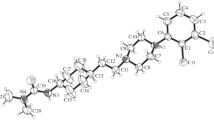Abstract
Aripiprazole, 7-[4-[4-(2,3-dichlorophenyl)-1-piperazinyl]butoxy]-3,4-dihydrocarbostyril, is an important new neuroleptic drug used in the treatment of schizophrenia and related psychoses. This study elucidates its detailed molecular structure and two preferred conformational forms, and relates to the solvates of this compound when crystallized from different environments. The latter is associated with the hydrogen-bonding capacity of aripiprazole through the piperazinyl and dihydrocarbostyril functions. Four unique crystal forms of this compound have been characterized using X-ray single crystal determinations, including an anhydrous structure (1), methanol (2) and hemi-ethanol (3) solvates and a hydrate (4). They were found to consist of hydrogen bonded dimers of the aripiprazole moieties that involve the cyclic (–NH–CO–)2 di-amide interaction synthon in 1–3 (with the solvent molecules attached to them in 2 and 3), or of hydrogen bonded polymeric aggregates sustained by extended multiple bonding through water bridges in 4. These modes of supramolecular association involve two different conformers with similar energy of the drug moiety.
Similar content being viewed by others
References
P. Lawler, C. Prioleau, M.M. Lewis, C. Mak, D. Jiang, J.A. Schetz, A.M. Gonzalez, D.R. Silbey, and R.B. Mailman: Neuropsychopharmacology 20, 612 (1999). See also at the Web site: http://www.biopsychiatry.com/aripiprazole.htm
Bernstein J., 2002 Polymorphism in Molecular Crystals Clarendon Press, Oxford
(a) S.M. Reutzel-Edens, J.K. Bush, P.A. Magee, G.A. Stephenson, and S.R. Byrn: Cryst. Growth Des. 3, 897 (2003); (b) I. Wawrzycka-Gorczyca, A.E. Koziol, M. Glice, and J. Cybulski: Acta Cryst. E60, o66 (2004)
(a) A. Altomare, M.C. Burla, M. Camalli, M. Cascarano, C.␣Giacovazzo, A. Guagliardi, and G. Polidori: SIR-97. J. Appl. Crystallogr. 27, 435 (1994); (b) G.M. Sheldrick: SHELXL-97. Program for the Refinement of Crystal Structures from Diffraction Data, University of Göttingen (1997)
(a) F. Allen, P.R. Raithby, G.P. Shields, and R. Taylor: Chem. Commun. 1043 (1998); (b) O. Almarsson and M.J. Zaworotko: Chem. Commun. 1889 (2004)
Accelrys, Inc., 2003. CERIUS2 Molecular Modeling Program, Version 4.8.1 (utilizing UFF, CVFF_950 and related force-fields), Accelrys, San Diego, USA
(a) G.R. Desiraju and R. Parthasarathy: J. Am. Chem. Soc. 111, 8725 (1989); (b) In F.H. Allen (ed.), The Cambridge Crystallographic Database. Acta Cryst. B58, 380 (2002)
Etter M.C.. 1991 J. Phys. Chem. 95:4601
Jeffrey G.A. 1997 An Introduction to Hydrogen Bonding Oxford University Press, Oxford, UK
Acknowledgement
The support of Teva, Pharmaceutical Industries, Ltd. is gratefully acknowledged.
Author information
Authors and Affiliations
Corresponding author
Rights and permissions
About this article
Cite this article
Tessler, L., Goldberg, I. Crystal Structures of Aripiprazole, a New Anti-psychotic Drug, and of its Inclusion Compounds with Methanol, Ethanol and Water. J Incl Phenom Macrocycl Chem 55, 255–261 (2006). https://doi.org/10.1007/s10847-005-9042-5
Received:
Accepted:
Published:
Issue Date:
DOI: https://doi.org/10.1007/s10847-005-9042-5



